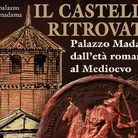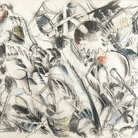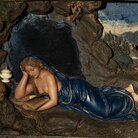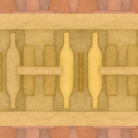Remoria

Valerio Mattioli, Remoria, acquedotto I Ph. Akoi
Dal 10 February 2022 al 22 May 2022
Roma
Luogo: MACRO - Museo di Arte Contemporanea
Indirizzo: Via Nizza 138
Orari: Martedì, mercoledì, giovedì e domenica: 12.00 – 20.00 Venerdì e sabato: 12.00 – 22.00 Lunedì chiuso Ultimo ingresso 30 minuti prima della chiusura
Enti promotori:
- Roma Culture
Costo del biglietto: ingresso gratuito
Telefono per informazioni: +39 06 696271
E-Mail info: info@museomacro.it
Sito ufficiale: http://www.museomacro.it
Remoria non esiste e non è mai esistita, è un’entità residuale di Roma, quella parte del mito di fondazione che, a causa dell’uccisione di Remo da parte del fratello Romolo, continua ad aleggiare nel passato e nel presente della città. Il Grande Raccordo Anulare, l’autostrada tangenziale che circonda Roma, conosciuta come GRA, è ciò che la riporta in vita. Sovvertendo il comune concetto di centro, questo anello tratteggia uno spazio aperto su cui nel secondo dopoguerra orbitano le borgate come Centocelle, Ostia, San Basilio, Laurentino. L’arcipelago della periferia dominante (che occupa il 99% della superficie della città) trasforma il marginale in uno spazio di leggende, riti e aneddoti.
Pubblicato nel 2019, il libro Remoria assume nel contesto della mostra che gli è dedicata dal MACRO un aspetto atmosferico. Il racconto e la tassonomia dell’anti-Città Eterna prende forma fisicamente nello spazio, abbandonando le pagine del suo autore, Valerio Mattioli.
Sul fondo della sala si stagliano dei paesaggi al negativo realizzati da Akoi 1 che riprendono, attraverso vedute di Google Earth, scorci periferici in cui si intravede il protagonista di questa storia: il GRA.
Alle pareti laterali, come affreschi di una navata, una serie di poster bilingue offrono al pubblico la lettura di Delirious Centocelle, un breve saggio dedicato al quartiere di Centocelle inizialmente pensato per essere pubblicato come appendice di Remoria. Il testo prende il nome da Delirious New York, il celebre libro dell’architetto Rem Koolhaas dedicato all’espansione urbana e alla relativa congestione di Manhattan.
Al centro della sala la natura totemica del GRA e della storia di Remoria è restituita attraverso un video, realizzato da VEGA in collaborazione con Michele Zanotti. La visione del duo di artisti e registi definisce il corpo della città di Remo attraverso tre elementi: una serie di scansioni 3D di resti architettonici della Roma antica che, fondendosi con quella contemporanea, limitano lo sviluppo della città; il personaggio del remoriano, una proiezione dell’abitante di Remoria nel contesto urbano attuale; il materiale d’archivio del libro che, sotto forma di una proiezione di ricordi, viene inserito nello spazio 3D della città.
Campioni trattati di brani di Stefano Tamburini, Lory D, Sick Luke e Noyz Narcos, selezionati da Mattioli e riprodotti contemporaneamente, evoca i rave party descritti nel libro e accompagna il paesaggio esperienziale di una Roma delle sottoculture, in un viaggio etnografico nelle discariche, nel mondo delle riviste e dei fumetti underground, nella cultura dei dark, punk e coatti.
Il progetto espositivo si espande inoltre con un programma di incontri con filosofi e scrittori, esperti e ricercatori di architettura, urbanistica e storia provenienti dalla città di Roma.
Valerio Mattioli, Remoria. La città invertita, minimum fax, 2019
Raccontare Roma oggi pare un’impresa disperata, non c’è narrazione che possa contenerla. Valerio Mattioli rovescia dunque la prospettiva: parte dal fantasma, dal doppio indicibile delle sue periferie per plasmare una mitologia parallela, che inizia nella Ostia di Amore tossico, passa per la nascita delle bande metropolitane, attraversa la stagione dei rave party, e atterra in un presente dominato da rovine piovute dal futuro, discariche e campi rom. Mescolando storia delle sottoculture, psicogeografia e romanzo di formazione, e annaffiando il tutto di scienza alchemica e fantahorror lovecraftiano, Remoria è una lunga lettera d’amore che dalla Centocelle del coatto sintetico Ranxerox viene indirizzata a tutte le periferie del pianeta, nel tentativo di far riemergere la città che potrebbe essere e che (ancora) non è.
Valerio Mattioli è editor per NERO. Ha scritto Superonda. Storia segreta della musica italiana (Baldini & Castoldi, 2016), Remoria. La città invertita (minimum fax, 2019) e Exmachina. Storia musicale della nostra estinzione (minimum fax, 2022).
Opening 10 febbraio, dalle 18 alle 21
Pubblicato nel 2019, il libro Remoria assume nel contesto della mostra che gli è dedicata dal MACRO un aspetto atmosferico. Il racconto e la tassonomia dell’anti-Città Eterna prende forma fisicamente nello spazio, abbandonando le pagine del suo autore, Valerio Mattioli.
Sul fondo della sala si stagliano dei paesaggi al negativo realizzati da Akoi 1 che riprendono, attraverso vedute di Google Earth, scorci periferici in cui si intravede il protagonista di questa storia: il GRA.
Alle pareti laterali, come affreschi di una navata, una serie di poster bilingue offrono al pubblico la lettura di Delirious Centocelle, un breve saggio dedicato al quartiere di Centocelle inizialmente pensato per essere pubblicato come appendice di Remoria. Il testo prende il nome da Delirious New York, il celebre libro dell’architetto Rem Koolhaas dedicato all’espansione urbana e alla relativa congestione di Manhattan.
Al centro della sala la natura totemica del GRA e della storia di Remoria è restituita attraverso un video, realizzato da VEGA in collaborazione con Michele Zanotti. La visione del duo di artisti e registi definisce il corpo della città di Remo attraverso tre elementi: una serie di scansioni 3D di resti architettonici della Roma antica che, fondendosi con quella contemporanea, limitano lo sviluppo della città; il personaggio del remoriano, una proiezione dell’abitante di Remoria nel contesto urbano attuale; il materiale d’archivio del libro che, sotto forma di una proiezione di ricordi, viene inserito nello spazio 3D della città.
Campioni trattati di brani di Stefano Tamburini, Lory D, Sick Luke e Noyz Narcos, selezionati da Mattioli e riprodotti contemporaneamente, evoca i rave party descritti nel libro e accompagna il paesaggio esperienziale di una Roma delle sottoculture, in un viaggio etnografico nelle discariche, nel mondo delle riviste e dei fumetti underground, nella cultura dei dark, punk e coatti.
Il progetto espositivo si espande inoltre con un programma di incontri con filosofi e scrittori, esperti e ricercatori di architettura, urbanistica e storia provenienti dalla città di Roma.
Valerio Mattioli, Remoria. La città invertita, minimum fax, 2019
Raccontare Roma oggi pare un’impresa disperata, non c’è narrazione che possa contenerla. Valerio Mattioli rovescia dunque la prospettiva: parte dal fantasma, dal doppio indicibile delle sue periferie per plasmare una mitologia parallela, che inizia nella Ostia di Amore tossico, passa per la nascita delle bande metropolitane, attraversa la stagione dei rave party, e atterra in un presente dominato da rovine piovute dal futuro, discariche e campi rom. Mescolando storia delle sottoculture, psicogeografia e romanzo di formazione, e annaffiando il tutto di scienza alchemica e fantahorror lovecraftiano, Remoria è una lunga lettera d’amore che dalla Centocelle del coatto sintetico Ranxerox viene indirizzata a tutte le periferie del pianeta, nel tentativo di far riemergere la città che potrebbe essere e che (ancora) non è.
Valerio Mattioli è editor per NERO. Ha scritto Superonda. Storia segreta della musica italiana (Baldini & Castoldi, 2016), Remoria. La città invertita (minimum fax, 2019) e Exmachina. Storia musicale della nostra estinzione (minimum fax, 2022).
Opening 10 febbraio, dalle 18 alle 21
SCARICA IL COMUNICATO IN PDF
macro museo di arte contemporanea
·
vega
·
akoi 1
·
michele zanotti
·
dom
·
claudio kulesko
·
nicola lagioia
·
annalisa metta
COMMENTI

-
 Dal 20 December 2025 al 20 April 2026
Caserta | Reggia di Caserta
Dal 20 December 2025 al 20 April 2026
Caserta | Reggia di Caserta
Regine: trame di cultura e diplomazia tra Napoli e l’Europa
-
 Dal 19 December 2025 al 23 March 2026
Torino | Palazzo Madama - Museo Civico d’Arte Antica
Dal 19 December 2025 al 23 March 2026
Torino | Palazzo Madama - Museo Civico d’Arte Antica
Il castello ritrovato. Palazzo Madama dall’età romana al medioevo
-
 Dal 17 December 2025 al 19 January 2026
Roma | Palazzo della Cancelleria
Dal 17 December 2025 al 19 January 2026
Roma | Palazzo della Cancelleria
De Humana Mensura di Linda Karshan
-
 Dal 18 December 2025 al 12 April 2026
Firenze | Gallerie degli Uffizi
Dal 18 December 2025 al 12 April 2026
Firenze | Gallerie degli Uffizi
Cera una volta. Sculture dalle collezioni medicee
-
 Dal 11 December 2025 al 9 April 2026
Firenze | Museo Archeologico Nazionale di Firenze
Dal 11 December 2025 al 9 April 2026
Firenze | Museo Archeologico Nazionale di Firenze
Icone di Potere e Bellezza
-
 Dal 11 December 2025 al 11 January 2026
Roma | Palazzo Esposizioni Roma
Dal 11 December 2025 al 11 January 2026
Roma | Palazzo Esposizioni Roma
Giorgio Morandi nella Collezione Eni. Un viaggio attraverso la storia culturale del cane a sei zampe e l’eredità di Enrico Mattei


